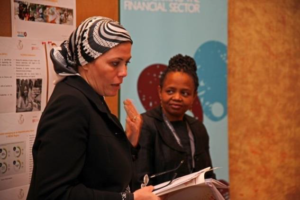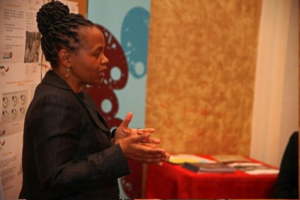Promoting gender equality
The objective of our programmes is to raise awareness among policymakers and relevant stakeholders of women’s distinct financial needs. We promote gender sensitive national financial inclusion processes by building capacity of policymakers and private sector actors to implement successful reform and financial sector development programmes in Africa and the Middle East and North Africa (MENA) region.
Our programmes work closely together on increasing women’s access to financial services in Egypt drawing on lessons learnt from countries like Zambia, Mozambique and Ruanda where MFW4A has accompanied similar reform processes. The intention is to share experiences between Sub-Sahara Africa and the MENA region. While the positive impact of financial inclusion is widely acknowledged and the role of women stressed, the level of financial inclusion in the MENA region is one of the lowest worldwide.
In the MENA region, 85 million adults lack access to formal financial services and operate outside the formal financial system and women have even lower levels of access than men. The high rate of exclusion of women from the financial system is closely correlated with high poverty rates and the large share of women who do not hold formal wage-earning employment, but legal and cultural barriers also play a role in keeping women financially excluded (see Figure 1).
Turning to Egypt, according to Findex, the percentage of Egyptians with an account at a formal financial institution is 14% with women’s inclusion levels being 9% and men’s more than twice this level at 19%.1 Women account for 10-25% of bank clients and more women entrepreneurs cite the lack of access to finance as a major constraint than men.
1 Findex Database 2015
Broad societal and economic change is fundamental to empowering women in order to engage fully in society and economy, whereas we focus our work on policies related to financial sector development.
In order to show policy makers and other stakeholders what could be done to facilitate women’s access to financial services and to achieve better outcomes for men and women alike, a set of policy recommendations for Africa was developed under the umbrella of the Partnership Making Finance Work for Africa (MFW4A), an initiative for African governments, the private sector, and partners supporting financial sector development across the continent. This process was strongly supported by New Faces New Voices (NFNV), a pan-African network of women in finance, and other stakeholders including the East African Community (EAC), Bank of Zambia, microfinance institutions, commercial banks, development partners and international experts. These financial sector policy recommendations were published in the Policy Brief: Advancing African Women’s Financial Inclusion, which is directed at governments, central banks, regulatory and supervisory authorities and other stakeholders involved in the policy-making and advocacy process.
As policy interventions help close the gender gap, we brought the policy recommendations to the national level in Egypt. We engaged with major stakeholders in the sector and decided to underpin the policy recommendations with country-specific data and findings for Egypt which led us to conducting a market assessment to look at the supply, demand, and enabling environment for
increasing access to financial services for women. This study we are sharing at the moment with the leading players in the financial sector (including the Egyptian Financial Supervisory Authority (EFSA), the Central Bank of Egypt (CBE) and the Social Fund for Development (SFD) our intention is not only to increase awareness of the topic but also to incorporate these institution’s views and ideas.
While building awareness of women’s financial needs in different market segments, EFSA Head Sherif Sami committed himself to a financial education programme that will be launched in cooperation with EFSA, CBE and Egypt Post. The newspaper coverage can be found at: http://www.dailynewsegypt.com/2015/05/16/cbe-efsa-cooperate-for-financial-education-programme/.
Our research shows that although policymakers, regulators and financial institutions in Egypt are currently promoting financial inclusion, the success of these initiatives would be greatly improved if efforts were better coordinated. One example is the difference in regulatory approaches relating to financial inclusion for women between CBE and EFSA. There is a great opportunity for policy makers, regulators, development partners and financial services provides to create one common platform, which can be used to formulate an industry strategy to tackle and address issues of financial inclusion not only for women but for different groups. A taskforce would bring different stakeholders together, avoid duplication and ensure sustained impact.
From our work we experienced that to have a national leader championing the initiative is vital and necessary to drive the process. It is important to have role models and innovative ideas that are promoted. This is why GIZ together with the Regional Microfinance Network of Arab Countries “Sanabel” committed to promote the development of innovative financial services for women in the Arab Countries. This is done through a GIZ/Sanabel Award that recognizes Microfinance Institutions (MFIs) that demonstrate innovative approaches to enhance women’s access to financial services. Applications for 2015 came from eight MFIs: Egypt (3), Jordan (2), Palestinian Territories (1) and Yemen (2). The 2015 GIZ/Sanabel Award, which was presented at the Sanabel Annual Conference hosted in Sharm El Sheikh in October 2015, was given to two MFIs instead of one due to their
competitive innovations: Al Amal Microfinance Bank from Yemen and Dakahlia Businessmen Association for Community Development (DBACD) from Egypt won jointly the Award.
Al Amal Bank focused in their entry on rural women in Yemen with products designed specifically to meet the women’s needs. Collective rural groups allow women to borrow up to USD 1,000 with the precondition of managing a micro or a small project and joining the saving group with women of her village. Offered as well is a financial inclusion service for mothers to encourage them to save when opening a free savings account. Al Amal Bank uses technology innovatively by delivering their services through a mobile bank branch connected via the internet to the main bank and providing a phone services through which women can pay bills and transfer money.
DBACD focused on enhancing their products to meet the emerging needs of women. They introduced a credit product with a maximum of USD 510. Women can pay back through weekly or monthly instalments and are provided with financial literacy training. In addition the customers are trained to market and price their products. Moreover DBACD recruited women loan officers to better deal and reach women in rural areas as they live in the same area as their women’s clients. Their approaches to provide women with financial products will be internationally promoted.
Gender as a quality feature of our work
While we focus in our policy recommendations on women, it is always stressed that the positive impact of financial inclusion on women has also a positive knock-on effect on men, the entire household and consequently, the overall economic situation of a country. Financial institutions, multilateral and bilateral organizations, non-profit entities and the private sector are increasingly aware of the importance of empowering women economically by increasing their access to finance. GIZ and partnerships like MFW4A and New Faces New Voices provide platforms for dialogue and exchange in this field. It is necessary to bundle and build on existing knowledge. Partner who initially were reluctant, tend to see more value in the topic if there is underlying data and examples from peers. This we noticed with the stakeholders in Egypt as well. The topic gets continuous attention from the donor community and we had already meetings with IDRC, IFC and World Bank who are interested in our activities.
Our programmes used the Annual Conference of the Regional Microfinance Network of Arab Countries “Sanabel” in 2015 as a forum to share knowledge and impediments to women’s financial inclusion in the MENA region. The panel discussion: “Does Financial Inclusion Work for Women too?” focused on strategies and frameworks that could support national financial inclusion efforts.
Gender and RBM
Both GIZ Programmes “Support to the Partnership Making Finance work for Africa (MFW4A)” and the “Promotion of the Microfinance Sector in the MENA Region (MFMR)” have a gender sensitive Result Based Monitoring (RBM) systems. As the two programmes have their own gender indicators, the programme progress in achieving them is documented and reported to BMZ.
The MFMR’s indicator related to the knowhow of an annually identified gender-sensitive financial product is regionally spread and implemented through the GIZ/Sanabel gender award. There is also a country-specific diagnostic on Women and Access to Financial in Egypt that is being discussed by the stakeholders in Egypt. The results in the area of gender are therefore an integral part of the M&E system and systematically recorded.
Our three key success factors to promote financial sector development for women in Africa are:
1 To have a champion/Graca Machel as well as a national champion to drive the process
2 cooperation between GIZ programmes
3 To include the perspective of the private sector
The table below shows a comparison between Egypt and other lower middle-income countries in Africa, Kenya and Zambia. It is notable that although Egypt’s poverty rate of 26% is less than half that of Zambia’s at 60%, it underperforms Kenya and Zambia in terms of the percentage of banked men and women.
Although Egypt has the highest Gross National Income (GNI) per capita of the four countries, its financial inclusion levels in general (and for women) are extremely low, even where the country is more populous, as is the case with Nigeria. Another striking difference is in the usage of mobile accounts where the gulf ranges between 1% for Egypt and 58% for Kenya. This confirms that there are opportunities to increase women’s and men’s financial inclusion. One way could be digitizing government and private sector wages, which could help cut the number of unbanked by 7%. Technology can also spur account usage and transform the way domestic payments are made: for instance 355 million adults in developing countries with an account report sending and receiving remittances in cash over the counter. Moreover, 1.3 billion adults with account in developing countries pay utility bills in cash and over half a billion of adults with an account in developing countries pay school fees in cash. Access to digital payments, through mobile phone or point of sales creates opportunities to provide more affordable and convenient payment options.
The table below, which is based on the World Bank’s Little Data Book on Financial Inclusion, provides another comparison of Egypt to African low middle-income countries.
Submitted by the GIZ Programmes:
Promotion of the Microfinance Sector in the MENA Region (MFMR), a Cairo-based regional programme covering Egypt, Jordan and the Palestinian Territories, contact person: Mehrechane Nayel, mehrechane.nayel@giz.de
Support to the Partnership Making Finance work for Africa (MFW4A), a pan-African programme based in Eschborn, contact person: Carol Schmidt, carol.schmidt@giz.de

 GIZ Gender Website
GIZ Gender Website
